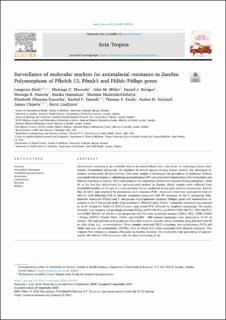| dc.contributor.author | Sitali, Lungowe | |
| dc.contributor.author | Lindtjørn, Bernt | |
| dc.contributor.author | Mwenda, Mulenga C. | |
| dc.contributor.author | Miller, John M. | |
| dc.contributor.author | Bridges, Daniel J. | |
| dc.contributor.author | Hawela, Moonga B. | |
| dc.contributor.author | Hamainza, Busiku | |
| dc.contributor.author | Mudenda-Chilufya, Mutinta | |
| dc.contributor.author | Chizema-Kawesha, Elizabeth | |
| dc.contributor.author | Daniels, Rachel F. | |
| dc.contributor.author | Eisele, Thomas P. | |
| dc.contributor.author | Nerland, Audun H. | |
| dc.contributor.author | Chipeta, James | |
| dc.date.accessioned | 2021-03-03T09:17:48Z | |
| dc.date.available | 2021-03-03T09:17:48Z | |
| dc.date.created | 2020-12-03T20:18:06Z | |
| dc.date.issued | 2020-12 | |
| dc.Published | Acta Tropica. 2020, 212 105704-105704. | |
| dc.identifier.issn | 0001-706X | |
| dc.identifier.uri | https://hdl.handle.net/11250/2731323 | |
| dc.description.abstract | Antimalarial resistance is an inevitable feature of control efforts and a key threat to achieving malaria elimination. Plasmodium falciparum, the deadliest of several species causing human malaria, has developed resistance to essentially all antimalarials. This study sought to investigate the prevalence of molecular markers associated with resistance to sulfadoxine-pyrimethamine (SP) and artemether-lumefantrine (AL) in Southern and Western provinces in Zambia. SP is used primarily for intermittent preventive treatment during pregnancy, while AL is the first-line antimalarial for uncomplicated malaria in Zambia. Blood samples were collected from household members of all ages in a cross-sectional survey conducted during peak malaria transmission, April to May of 2017, and amplified by polymerase chain reaction (PCR). Amplicons were then analysed by high-resolution melt following PCR to identify mutations associated with SP resistance in the P. falciparum dihydrofolate reductase (Pfdhfr) and P. falciparum dihydropteroate synthase (Pfdhps) genes and lumefantrine resistance in the P. falciparum multi-drug resistance 1 (Pfmdr1) gene. Finally, artemether resistance was assessed in the P. falciparum Kelch 13 (PfK13) gene using nested PCR followed by amplicon sequencing. The results showed a high frequency of genotypic-resistant Pfdhps A437G (93.2%) and Pfdhfr C59R (86.7%), N51I (80.9%), and S108N (80.8%) of which a high proportion (82.4%) were quadruple mutants (Pfdhfr N51I, C59R, S108N +Pfdhps A437G). Pfmrd1 N86Y, Y186F, and D1246Y - NFD mutant haplotypes were observed in 41.9% of isolates. The high prevalence of quadruple dhps/dhfr mutants indicates strong antifolate drug pressure from SP or other drugs (e.g., co-trimoxazole). Three samples contained PfK13 mutations, two synonymous (T478 and V666) and one non-synonymous (A578S), none of which have been associated with delayed clearance. This suggests that artemisinin remains efficacious in Zambia, however, the moderately high prevalence of approximately 40% Pfmdr1 NFD mutations calls for close monitoring of AL. | en_US |
| dc.language.iso | eng | en_US |
| dc.publisher | Elsevier | en_US |
| dc.rights | Navngivelse 4.0 Internasjonal | * |
| dc.rights.uri | http://creativecommons.org/licenses/by/4.0/deed.no | * |
| dc.title | Surveillance of molecular markers for antimalarial resistance in Zambia: Polymorphism of Pfkelch 13, Pfmdr1 and Pfdhfr/Pfdhps genes | en_US |
| dc.type | Journal article | en_US |
| dc.type | Peer reviewed | en_US |
| dc.description.version | publishedVersion | en_US |
| dc.rights.holder | Copyright The authors | en_US |
| dc.source.articlenumber | 105704 | en_US |
| cristin.ispublished | true | |
| cristin.fulltext | original | |
| cristin.qualitycode | 1 | |
| dc.identifier.doi | 10.1016/j.actatropica.2020.105704 | |
| dc.identifier.cristin | 1856032 | |
| dc.source.journal | Acta Tropica | en_US |
| dc.source.40 | 212 | |
| dc.source.pagenumber | 1-8 | en_US |
| dc.source.volume | 212 | en_US |

